Klaus Kertess - Trisha Brown Interviews (2003)
Friday, May 30, 2008
Download this at KaraGarga.
Trisha Brown was an early participant in the expanded cinema and new dance movements in New York City in the 60s and 70s. For Homemade (1966), she performed a dance with a movie projector to her back that threw a film of her dancing created by Robert Whitman on the wall behind and above her, complementing her movements and fracturing the space of the performance. She continued to have an interest in film and video in reconceptualizing dance and performance art in the 70s and 80s.
This is a companion dvd to the Early Works, 1966-1979 dvd in which she talks with art historian Klaus Kertess about her dance education, her work with the Judson Dance Theater and her fellow choreographers.
 Download this at KaraGarga.
Download this at KaraGarga.
at 1:09 PM
Trisha Brown - Early Works, 1966-1979 (1966)
Download this at KaraGarga.
Trisha Brown, one of the most acclaimed choreographers of contemporary dance, first came to notice in New York in the 1960s. Along with like-minded artists,Yvonne Rainer, Steve Paxton and Simone Forti, she pushed the limits of what was then considered appropriate movement for choreography, and changed modern dance forever. Founding her company in 1970, Brown developed her own choreography and style with her own unique ideas of movement. The first DVD of this two DVD set presents film and video footage by filmmakers, including Babette Mangolte, Carlotta Schoolman and Jonathan Demme, of eighteen of Brown’s major performances from 1966 to 1979. 

 Download this at KaraGarga.
Download this at KaraGarga.
at 1:07 PM
Olaf Breuning - Home 2 (2007)
Tuesday, May 20, 2008
Download this at KaraGarga.
Born 1970 in Schaffhausen, Switzerland; lives in New York, New York
Commingling reality and illusion, authenticity and artifice, barbarism and civility, Olaf Breuning creates photographs, films, sculptures, and installations that draw heavily from popular culture and a collective visual iconography. He combines these contemporary aesthetics with more primal shared drives: violence, sexuality, ritual, and companionship. The divergent impulses collide, often with absurd and hilarious results, as Breuning exploits the thin line between humor and pain.
In his 2007 exhibition at Zurich’s Migros Museum für Gegenwartskunst, Breuning employed art transport boxes as supports for his photographs, drawings, and sculptures. The crates and packing material, which also frame the exhibition’s architecture, take on multiple connotations as vehicles of transport and change. Arranged in a plexiglass showcase, dozens of small ceramic pieces, each incongruously fitted with a pair of large cartoonish eyes, comprise The Collectors (2007). These comical figures, mounted on the side of a carton and staring into the exhibition space, conjure comparisons to the collectors who roam international art fairs, frenziedly purchasing and packaging works. In the chromogenic print 20 Dollars (2007), five young African boys, slightly bemused but smiling broadly, present to the camera $20 bills given to them by the photographer. The detritus of a smoldering garbage heap is strewn around their feet. Mounted on and framed by an oversize shipping crate balanced on a smaller box, the glossy photograph appears broadcast from a largescreen entertainment center, underlining the distance between subject and viewer. The disparities illustrated by the image, especially between the entrenched poverty and easily gained currency, suggest the futility— and perhaps offensiveness—of looking to tourism and globalization as effective vehicles for change in this impoverished scene.
At the center of the Migros exhibition is Home 2 (2007), a video in which Breuning expands on themes of dislocation, homelessness, and cultural identity explored in his 2004 video Home. Here the original narrator, again played by actor Brian Kerstetter, joins a tourist group traveling through Papua New Guinea. He stumbles his way through assorted villages and tribes, variously charming or insulting his fellow tourists and the “natives” he encounters. In this foreign environment his mind is transported to locations of previous travel or fantasy as he sifts through notions of identity and belonging. Home is a universal, but also a specific, construct. “Each has a home they want to go to, like me,” the narrator opines as his journey comes to an end. The viewer is left with the distinct notion that neither the traveler nor the world he has left is enriched by the experience. Contextualizing the helplessness of today’s global citizen, Breuning examines a basic human quest for commonality in an increasingly global, but ever more fragmented, world. STACEY GOERGEN

 Download this at KaraGarga.
Download this at KaraGarga.
at 7:57 PM
Harun Farocki - Gefängnisbilder aka Prison Images (2000)
Wednesday, May 14, 2008
Download this at KaraGarga.
A film composed of images from prisons. Quotes from fiction films and documentaries as well as footage from surveillance cameras. A look at the new control technologies, at personal identification devices, electronic ankle bracelets, electronic tracking devices. The cinema has always been attracted to prisons. Today's prisons are full of video surveillance cameras. These images are unedited and monotonous; as neither time nor space is compressed, they are particularly well-suited to conveying the state of inactivity into which prisoners are placed as a punitive measure. The surveillance cameras show the norm and reckon with deviations from it. Clips from films by Genet and Bresson. Here the prison appears as a site of sexual infraction, a site where human beings must create themselves as people and as a workers. In Un Chant d'amour by Jean Genet, the guard looks in on inmates in their cells and sees them masturbating. The inmates are aware that they are being watched and thus become performers in a peep show. The protagonist in Bresson's Un Condamné à mort s'est échappé turns the objects of imprisonment into the tools of his escape. These topoi appear in many prison films. In newer prisons, in contrast, contemporary video surveillance technology aims at demystification. (Harun Farocki)


 Full untouched DVD released from Goethe Institut. German audio; Spanish, French, Russian, English, Japanese, Portuguese, Deutsch, Zulu subtitles.
Full untouched DVD released from Goethe Institut. German audio; Spanish, French, Russian, English, Japanese, Portuguese, Deutsch, Zulu subtitles.
Download this at KaraGarga.
at 9:41 AM
Ken Adams - Strange Attractor (2003)
Tuesday, May 13, 2008
Download this at KaraGarga.
Reviews:
Trippy psychedelic graphics, weird techno storyline, November 8, 2003
Reviewer: A viewer (Hoboken, NJ USA)
Truly amazing! Better than Alien Dreamtime, but in the same vein. The graphics are even better, and the music is compelling even without Stephen Kent on didgeridu. What this one has that AD lacks is a storyline with characters. If you're familiar with Terrence McKenna's writings, you'll have no trouble figuring out what "blue apple" really is!
Psychedelic experience, September 26, 2003
Reviewer: zap (Austin, Tx US of A) - See all my reviews
very interesting... Lady Miss Kier (of Dee-Lite fame) makes a groovy and bizarre appearance. great CGI stuff here, plus an interesting storyline that weaves in and out of the graphics. philosophical, makes you think...
Neo-psychedelia at its finest. - Patrick Sanders, Movie Mania
An experience that viscerally demonstrates, in
sight and sound, the phenomenal power of the psychedelic imagination and eroticizes intelligence. - Robyn Sean Peterson
One of the most meaningful projects to come out of the Rave culture thus far.... frequently stunning visual mélange. - Alternative Press
Rose X's relentless image mutation is the richest, most nuanced motion picture psychedelia this reviewer has ever seen with his eyes open. - City Pages
... transcends the historical and the anthropological...stretch psychedelic computer effects to new limits. - R.U. Sirius in Wired
Rose X is using the same techniques explored by techno/electronica and applying them to film.
...The psychedelic imagination is on the rise and computers are providing the sounds and images for the journey. - Interview with Rose X in Fringecore Magazine
Cast:
Terence McKenna, Lady Miss Kier of Deee*Lite, Britt Welin, Ken Adams





 Download this at KaraGarga.
Download this at KaraGarga.
at 6:08 PM
Glauber Rocha - Abertura (1979)
Download this at KaraGarga.
"One of the most daring and radical show presented in the brazilian television: "Abertura". It was broadcasted between february an june, 1979 with weekly editions, presented by brazilian filmaker Glauber Rocha ("God and the Devil in the Land of the Sun", "Anguished Land" etc). The video is a compilation of interviews, statements and characters about the political and cultural situation of the country during the Mitary Regime."
Directed by: Fernando Barbosa Lima and Glauber Rocha
Broadcasted by: TV Tupi
Runtime: 49 minutes
Color: Black and White
Audio Language: Brazilian Portuguese



 Download this at KaraGarga.
Download this at KaraGarga.
at 6:05 PM
Christian Marclay - More Encores (1988)
Monday, May 12, 2008
Download this at KaraGarga. Track listing: Johann Strauus, John Zorn, Martin Denny, Frederic Chopin, Fred Frith, Louis Armstrong, Arthur Ferrante & Louis Teicher, John Cage, Maria Callas, Jimi Hendrix, Jane Birkin & Serge Gainsbourg, Christian Marclay.
Track listing: Johann Strauus, John Zorn, Martin Denny, Frederic Chopin, Fred Frith, Louis Armstrong, Arthur Ferrante & Louis Teicher, John Cage, Maria Callas, Jimi Hendrix, Jane Birkin & Serge Gainsbourg, Christian Marclay.
Since 1979 Christian Marclay has been experimenting, composing and performing with phonograph records. His interest in records, both as objects and bearers of sound, is expressed through sculpture, performance, video and music. In performance, he mixes a wide variety of records on up to eight turntables, fragmenting, repeating, altering speeds, playing the records backwards etc.
"One of the best improvisers around" said the Village Voice. Marclay has performed in Japan, Europe, the USA and throughout New York City, often collaborating with such avant-garde composers as John Zorn, David Moss, Elliot Sharp, Fred Frith, Arto Lindsay and Shelley Hirsch among others.
MORE ENCORES was originally released as a 10" vinyl record on No Mans Land in 1988, "composed entirely of records after whom each track is titled. "John Cage" is a recording of a collage made by cutting slices from several records and glueing them back into a single disc. In all other places the records were mixed and manipulated on multiple turntables and recorded analog with the use of overdubbing. A hand-crank gramophone was used in "Louis Armstrong"."
MORE ENCORES is a classic slice of primal Plunderphonia, the natural companion to John Oswald's suppressed Plunderphoncs masterpiece, featuring a series of viciously beautiful vinyl collages from this important and infulential sound sculptor and turntable terrorist.
Download this at KaraGarga.at 11:30 AM
Peggy Ahwesh - 73 Suspect Words & Heaven's Gate (2001)
Download this at KaraGarga.
Two text videos from a series that distills to a poetic and symbolic core, a variety of texts, source code, search results, and/or coded messages from the unruly databases that glut the net.
Only available on the DVD Pistolary: Films and Videos by Peggy Ahwesh.



Download this at KaraGarga.
at 11:12 AM
Marine Hugonnier - Ana Hanusova (2001)
Friday, May 9, 2008
Download this at KaraGarga.
"In the year 2000, I was asked by Camera Austria, an Austrian art magazine, to contribute to an issue published in response to the election of October 1999. This request gave me the opportunity to rethink, in a context of political and social imperatives, the role of artistic activity. After spending some time envisaging what a gesture in response to Camera Austria would require (a rethink of my relationship to History), I decided to invite a women, who had been part of one of the orchestras in the concentration camps to come and play a piece of music of her choice which would be broadcast live on the Austrian national radio channel, O1." - Marine Hugonnier
"I spent long months doing research which led me to meet a few survivors. I'm not sure that, for the first meetings, I was particularly convincing. Many of them wanted to forget. This raised the question of programmed memory loss and collective amnesia concerning history. These first meetings discouraged me for a time. I suddenly realized that there was certain legitimacy in the desire to forget - my own grandfather had never wanted to talk to me about what happened to him, pushing his refusal to confront the past to the point of never even going to see a war film at the cinema. I remained convinced, however, that it was still possible to confront this history with our everyday existence.
The video recording, which was filmed during the live broadcast on national radio O1 of Anna Hanusova's performance, includes images of Vienna. This images show the International Atomic Energy Authority, the UN building, the oil refinery (Olraffinerie Schwechat), the Sony and Microsoft buildings, the big wheel (the Riesenrad) and the Prater amusement park surrounding it, the Karl Marx Hof, a cinema in Vienna and the number 05 which the symbol of resistance in Austria. These various images, which punctuate the film, enable me to go beyond the political conflict specific to Austria and to place the event in an international context. These different images are to be seen as signs of our contemporary world at the dawn of cybernetics, nanotechnology, biotechnology and the mapping of DNA." - Marine Hugonnier
�Marine Hugonnier�s artworks are infused with her long-standing interest in the discipline of anthropology. They focus on and act out the differences between one type of perception and another: specifically the historical, social, and political ramifications of how we deal with our orientation in the present moment. That Hugonnier�s work does this makes it a covertly socio-political statement that refuses, and seeks to short-circuit in viewers on a one-by-one basis, the consensus of unthinking forward motion, routine of distraction, and easy amnesia prevalent amongst the occupants of big cities. Making works which consistently pull off this trick means never using the same aesthetic approach twice: over the past few years Hugonnier has slowly but steadily constructed an expandix of quiet unassuming and discrete works which viewers are bounced in slow motion, re-orientated and ref-framed in case by the slow, surprising transmission of the artwork�s qualities and its pervasive effect on their perceptual abilities." - Martin Herbert, Today is Yesterday's tomorrow from Marine Hugonnier, CGAC, 2001
Marine Hugonnier was born in Paris in 1969 and grew up in the United States and France; lives and works in London. Solo exhibitions of her work have been organized by Centro Galego de Arte Contempor�nea, Santiago de Compostela, Spain; Annet Gelink Gallery, Amsterdam; Kerstin Engholm Gallery, Vienna; and Chantal Crousel Gallery, Paris. Her group exhibitions have included Spiritus, Magasin 3, Stockholm Konsthall; Travers�es, l'ARC, Mus�e d'art Moderne de la Ville de Paris; Squatters, Fundac�o de Serralves, Porto, Portugal; Beau Monde: Toward a Redeemed Cosmopolitanism, Site Santa Fe's Fourth, International Biennial, New Mexico; My Generation, Atlantis Gallery, London; Movimientos Inmoviles, Museo de Arte Moderno, Buenos Aires; and Marine Hugonnier & Henrik Plenge Jakobson, Centre d�Art Neuch�tel, Neuch�tel, Swizterland.

 Download this at KaraGarga.
Download this at KaraGarga.
at 12:32 PM
Mark Leckey - Fiorucci Made Me Hardcore (1999)
Saturday, May 3, 2008
Download this at KaraGarga.

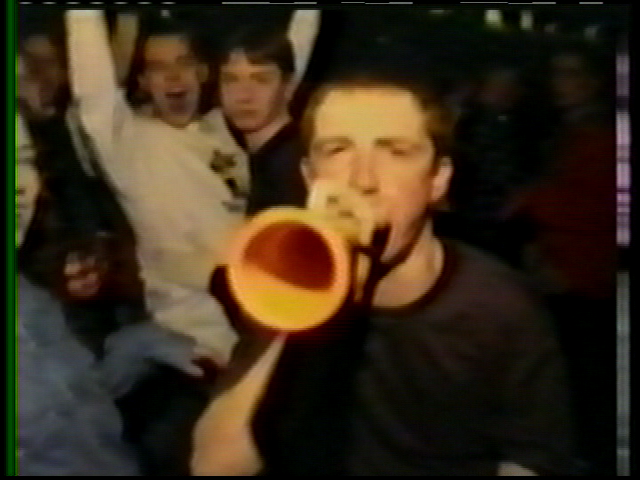
"Described by one commentator as the best thing they'd ever seen in a gallery, Fiorucci Made Me Hardcore is an extended paean to the unadulterated bliss of nocturnal abandon. A documentary of sorts, Leckey's video chronicles the rites of passage experienced by successive generations of British (sub)urban youth".
- Matthew Higgs, ArtForum
Fiorucci Made Me Hardcore uses found and original footage of discos and raves across Britain during the 70s, 80s and 90s. Details of clothing, technology, music and other cultural references surface briefly like uncanny folklore as the film explores a culture of collective leisure and consumption.
Download this at KaraGarga.
at 3:02 PM
Francis McKee - In Profile: Mariele Neudecker (2002)
Thursday, May 1, 2008
Download this at KaraGarga.
In Profile is a new series of monographic DVD publications on contemporary artists working with film and video. Born in Düsseldorf in 1965, Mariele Neudecker has lived and worked in the UK since 1985. Her work investigates the physical and psychological spaces that we, as viewers, carry within ourselves. She uses primary landscapes, representations taken from books or postcards, or those extracted from memory or from imagination. Using sculpture, film and photography she creates a sometimes playful frisson between historical cultural representations of the sublime landscape and our perception, imagination and memory of the reality of experience.

 Download this at KaraGarga.
Download this at KaraGarga.
at 8:29 PM
Ben Lewis - Art Safari: Sophie Calle (2005)
Download this at KaraGarga.
Sophie Calle is the Grand Dame of French contemporary art. Her famous works of art usually involve following a set of rules or a procedure – following a stranger to Venice; obeying a set of instructions from writer Paul Auster; or working as a hotel maid.
Her art combines romantic autobiography and detached conceptualism. She gives Ben permission to make a film about her on one condition: he has to think up a ritual or set of rules for her to follow, similar to the rules which govern her works of art.
Ben visits gallerists and theorists to take advice on what to suggest to her. He submits idea after idea. She rejects one after the other. Finally, in a final encounter with the artist, Ben realises that this ritual of rejection is the set of rules he wanted Sophie to follow.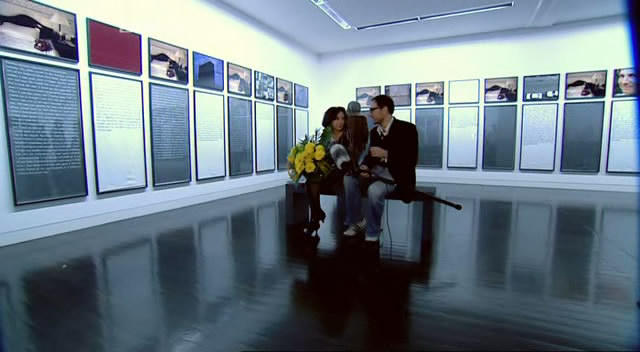
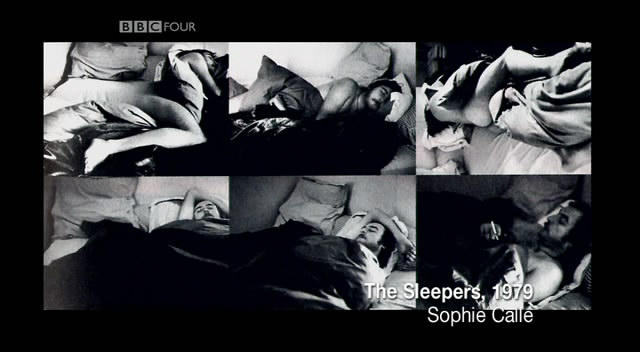
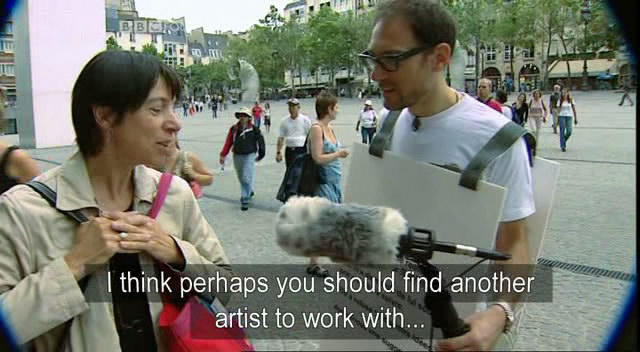
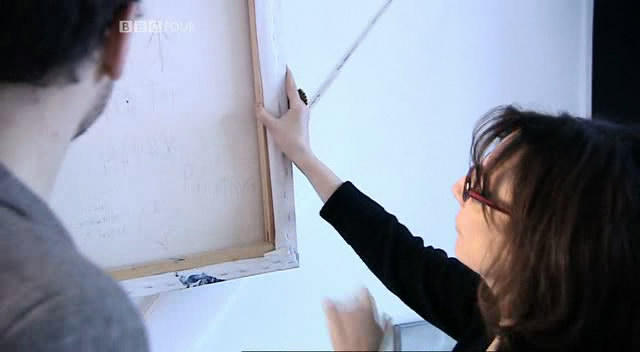
Download this at KaraGarga.
at 11:38 AM
Helena Almeida - Helena Almeida (2004)
Download this at KaraGarga.
Helena Almeida is a unique artist, with an exceptional and exemplary career, at many levels. Helena Almeida’s complex working method flows into the usage of black and white photographs, images of herself, in which the memory of an action, of a performance, seems to be depicted.
In the exhibition Pés no Chão, Cabeça no Céu (Feet on the Ground, Head in the Sky), the connection between Helena Almeida’s course and the physicality of the space that harbors the body is brought into focus.
Sente-me, Ouve-me, Vê-me (Feel me, Hear me, See me), from 1978/9, presented only once (and in an incomplete state) at the Galerie Erike + Otto Friedrich, and the series Seduzir (Seduce), produced between 2000 and 2002, which is presented here, complete for the first time. In both these series, video is used besides photography.
Sente-me, Ouve-me, Vê-me (Feel me, Hear me, See me) is a landmark in Helena Almeida’s work, because it is a polymorphous project that makes use of video, sound and photography, but also because it configured a project that brought together the sensorial side implied in the vocative addressed at the viewer, and the irony of its projective character: Vê-me (See me) is sound; Ouve-me (Hear me) is written on the mouth, as if sown in a suture; Sente-me (Feel me) refers to relations with inanimate objects.
The series of works generically entitled Seduzir (Seduce), of recent production, is composed of a large group of photographs of the artist’s feet, sometimes also of her hands, or even her body, frontal images. The series also includes a videographic work. It consists of a long action around a wooden stool, originally a study for the series – as can be confirmed by the coincidence of some photographs and some of the scenes of the video – but that finally established itself as an autonomous work, enormous in its intensity, and in the magnetism with which it seizes us.
Caught by the wires of Helena Almeida’s work, or suspended in its vocative, the recognition of the inner energy in artistic creation is always remarkable: the certainty of knowing that this is a unique path that cannot be walked again.
Delfim Sardo, January 2004
Biographical Note
Helena Almeida was born in 1934 in Lisbon, where she lives and works, and studied painting at Lisbon’s School of Arts. She started to show her work in the 1960’s. Her first solo exhibition took place in 1967, at the Buchholz Gallery in Lisbon. She as since exhibited in various galleries and museums, not only in Europe (Spain, Switzerland, France, among others) but also in Brazil, Macau, USA and Japan.








 Download this at KaraGarga.
Download this at KaraGarga.
at 12:02 AM